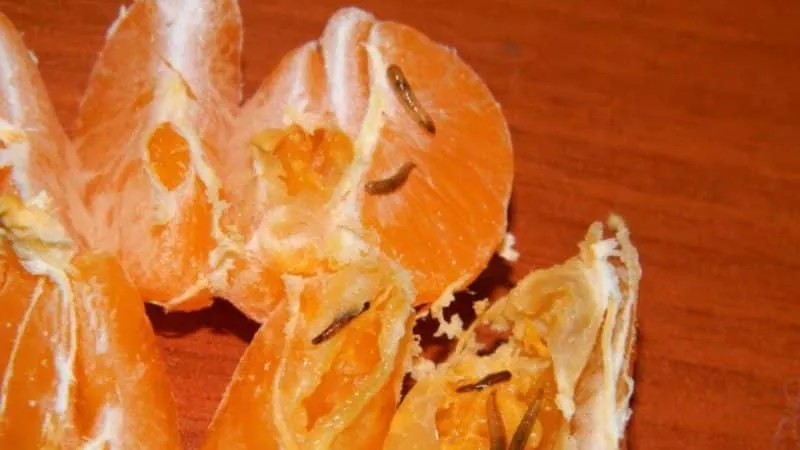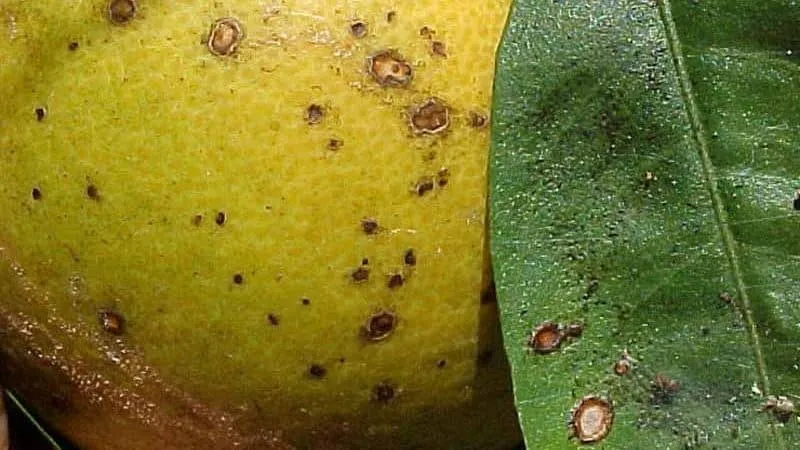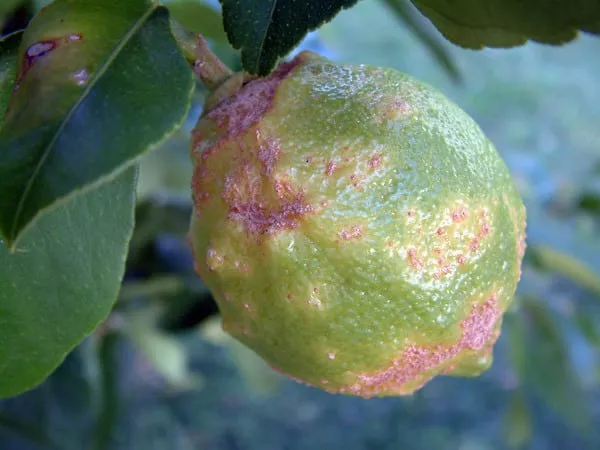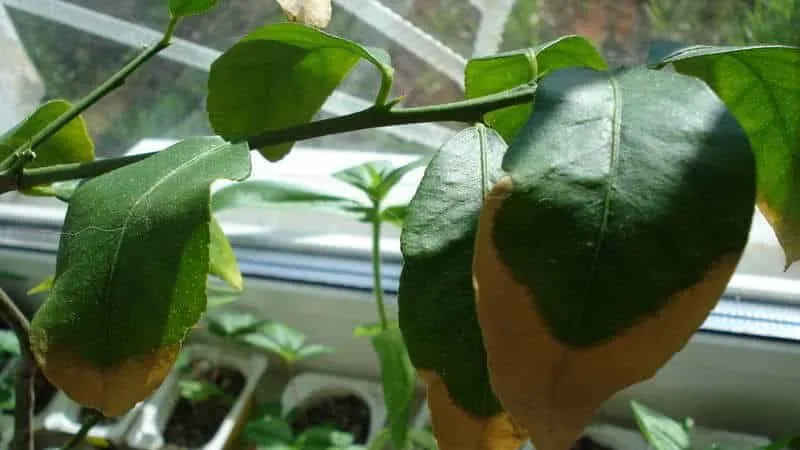Mandarin trees are often grown as houseplants. To ensure beautiful blooms and delicious fruit, proper care is essential: maintaining watering conditions, applying fertilisers, regular repotting, and protecting against diseases. If care rules are neglected or the plant is placed near unhealthy neighbours, indoor mandarins can fall victim to infections and pests.
Not all diseases can be treated, even if detected early. The same applies to pests. If worms have already infested the fruit, the harvest cannot be saved. How to protect mandarins from such problems, how to treat them, and whether damaged fruit can be eaten – read on.
Table of contents
Can Mandarins Have Worms?

Worms in mandarins are rare but real. They can appear in fruits bought from supermarkets. The risk of finding larvae in homegrown mandarins is extremely low.
Only two types of insects lay larvae in citrus fruits:
- Mediterranean fruit fly – lays larvae resembling maggots with a sharp black spike at the tail;
- Citrus fruit borer – a thin worm that feeds on mandarin flesh, carving tunnels inside.
These parasites enter mandarins while the fruit is still on the tree. Infestation is detected by dark spots, holes, or damage on the peel.
Fruit from indoor mandarin trees is rarely affected by such pests. This can only happen if the pot is placed outdoors or on an open balcony during warm weather.
There’s no need to treat indoor mandarins with insecticides specifically for worms. Preventive spraying in spring, before flowering, is sufficient if there was an issue the previous year.
If larvae are found in mandarins, the fruit should not be eaten. The waste products of these insects can cause intoxication.
Common Diseases of Mandarin Trees
Indoor mandarin trees are less prone to diseases than those grown outdoors, but the risk of infection still exists. This happens due to improper care, contaminated soil or planting material, or proximity to infected plants. The risk is especially high in summer if the pot is kept in a garden or on a balcony.
Indoor citrus plants suffer from both common and specific diseases. Some are easy to treat, while others are untreatable.
Anthracnose
Anthracnose is caused by a fungus. Without timely treatment, branches, young shoots, and leaves die, leading to the plant’s death. The infection also affects fruit, making it bitter-sour with an unpleasant smell and reducing shelf life.
Note! Mandarins can also contract anthracnose during storage.
Early treatment can save an infected mandarin tree. Key symptoms include:
- Light olive spots appear on leaves, darkening over time. In high humidity, they turn brown.
- Small dark spots form on shoot tips. Branches turn brown, then light grey, with swollen growths.
- White flowers develop red spots and eventually fall off, as do young fruit.
- Dark spots appear around the stem of the fruit, spreading and softening the rind.
Anthracnose thrives in high humidity and poor care conditions.
Treatment involves removing infected parts, applying tree wound sealant, and spraying with antifungal agents:
- Serenade – a biofungicide safe for humans and the environment.
- Score – a highly effective fungicide. Toxic – avoid consuming fruit if treated during flowering or fruiting.
- Iodine with milk – a folk remedy. Mix 1 litre of milk, 30 drops of iodine, and 4 litres of water.
Repeat treatments every 1–2 weeks, at least three times.
Gummosis
Gummosis is a fungal disease causing bark peeling, root and shoot death. In severe cases, fruit develops brown, wet rot.
Symptoms include:
- Long brown or red streaks on branches and trunk;
- Cracks oozing golden-yellow gum;
- Branch and leaf death if untreated;
- Brown rot on fruit.
Causes:
- Deep planting covering the root collar;
- Contaminated soil or tools;
- Poor drainage;
- Overwatering;
- Excess nitrogen fertilisers;
- Lack of potassium and phosphorus;
- Physical damage.
Treatment: Clean infected areas, apply a mix of 2 tbsp copper sulphate and 100 g lime in 1 litre of water, then seal with tree wound paste. Repeat until resolved. Remove infected branches entirely.
Warning! If leaves are affected, the tree cannot be saved and must be destroyed.
Citrus Scab
Citrus scab, a fungal infection, causes flower, leaf, and fruit drop, shoot death, and spoils harvests. Treatable early but fatal if ignored.
Symptoms:
- Yellow, translucent leaf spots turn into pink-grey warts.
- Warts merge on shoots, forming large growths that kill branches.
- Orange-brown spots on fruit cause premature drop.
High humidity and temperature activate the fungus.
Treatment: Prune infected parts, apply copper sulphate spray, and seal cuts.

Phytophthora
Phytophthora, a stubborn fungal disease, is hard to cure. If only the trunk is affected, recovery is possible. Root infections are fatal.
Brown, oily rings form on the trunk. Leaves drop, and the tree dies.
Young trees, especially those grafted onto orange rootstock, are most vulnerable.
Action: Uproot and inspect roots. Discard if infected. For trunk infections, scrape diseased tissue, treat with Score, and seal wounds. Repeat as needed.
Citrus Canker
Citrus canker, a bacterial disease, kills all above-ground parts.
Dark brown spots appear on leaves and fruit, which then dry and fall.
No cure exists. Destroy infected plants.

Mal Secco
Mal secco, an airborne fungal infection, spreads via tools and planting material.
Did you know? Outdoors, it strikes in spring; indoors, autumn to spring.
Symptoms:
- Branches turn orange-red inside;
- Leaves fall, leaving petioles attached.
No treatment. Destroy the tree.
Root Rot
Root rot, caused by fungi, decays roots. Symptoms appear late: yellowing leaves, no flowers or fruit.
Causes:
- Deep planting;
- Overwatering;
- Contaminated soil;
- Poor drainage;
- Cold irrigation water.
Treatment:
- Uproot, clean, and inspect roots.
- Cut infected roots with sterilised tools.
- Rinse with weak potassium permanganate solution, dust cuts with ash.
- Soak roots in Rooting Hormone for 12 hours, then repot in fresh soil.
- Reduce watering; wipe leaves with a damp cloth.
Tristeza
Tristeza, a viral disease, attacks bark. Resistant varieties carry it latently. Grafting infected material spreads it.
Symptoms in trees 5+ years old:
- Dull, bronze leaves with yellow veins;
- Branch dieback;
- Discoloured, dropping fruit.
No cure. Remove the tree.
Xyloporosis
Xyloporosis, a virus, lies dormant for up to 10 years before sudden activation.
It cracks and peels bark, oozing gum. Infected parts die.
No treatment. Destroy the tree.
Nutrient Deficiencies
Deficiency symptoms mimic diseases:
- Nitrogen – Yellow speckles, then overall yellowing.
- Phosphorus – Rusty leaf tips; dull foliage.
- Potassium – Vein-related leaf puckering.
- Manganese/Zinc/Iron – Pale leaves with dark veins.
Alkaline soil imbalance causes leaf drop.
Is the Tree Dead?

Untreated diseases kill mandarin trees. Signs of death:
- Leaf drop (if combined with other symptoms).
- Dry, brittle branches breaking off.
- Stunted growth.
Individually, these may not indicate death. Combined, they signal irreversible decline.
Prevention Tips
Prevention beats treatment:
- Disinfect tools, soil, and planting material.
- Control pests promptly.
- Water correctly.
- Use pots with drainage holes.
- Fertilise regularly.
- Repot when root-bound.
- Avoid sick neighbouring plants.
Conclusion
Wormy mandarins are rare, mostly in store-bought fruit. Eating them is unsafe.
Disease strikes even indoor trees, usually due to poor care or contaminated materials. Most cases are treatable if caught early. Recognise symptoms and act fast to save your tree.







